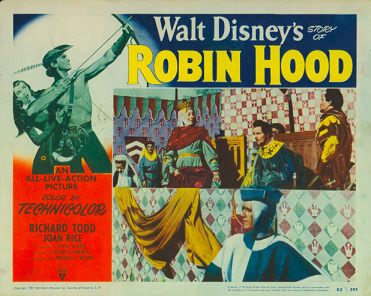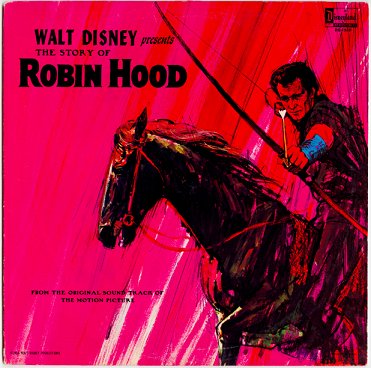May at The Walt Disney Family Museum features Walt Disney’s screen treatment of the Robin Hood tale, one of several films that Walt adapted from popular works of legend, literature, stage, and screen. Walt Disney’s The Story of Robin Hood and his Merrie Men screens daily through May at 1:00pm and 4:00pm (except Tuesdays, and May 5 and May 19). Further program information and tickets are available at the Reception and Member Service Desk at the Museum, or online by clicking here.
 Walt Disney’s second live-action feature produced in England,The Story of Robin Hood, differed from the first, Treasure Island, in some important ways. Not the least of these was the story. Legends involving the mythical character of Robin Hood had circulated for hundreds of years, and by the time Walt tackled his film, many of those legends had already found their way to the screen in numerous film adaptations. In particular, Walt’s picture would be following in the footsteps of two recognized film classics: the silent version starring Douglas Fairbanks, and the sound version starring Errol Flynn.
Walt Disney’s second live-action feature produced in England,The Story of Robin Hood, differed from the first, Treasure Island, in some important ways. Not the least of these was the story. Legends involving the mythical character of Robin Hood had circulated for hundreds of years, and by the time Walt tackled his film, many of those legends had already found their way to the screen in numerous film adaptations. In particular, Walt’s picture would be following in the footsteps of two recognized film classics: the silent version starring Douglas Fairbanks, and the sound version starring Errol Flynn.
The Douglas Fairbanks version of Robin Hood, released in 1922, still stands today as the most spectacular and lavishly produced film version of the story. Fairbanks was at the peak of his powers in 1922, having already established himself as the preeminent star of swashbuckling action adventures. As a founding partner in United Artists, he was also the producer of his own films, and spared no expense to mount his productions on an extravagant epic scale. The Fairbanks Robin Hood featured a castle which was one of the largest standing sets ever constructed for a Hollywood film (the banquet hall alone, it has been observed, was larger than the concourse of New York’s Pennsylvania Station). Along with this magnificence there was a full complement of pageantry, tournaments, swordplay and other action scenes, meticulously researched and accurate to the period of 12th-century England. At the center of it all was the ebullient personality of Fairbanks himself, engaging in his patented acrobatics and clearly having the time of his life as the hero of a boy’s adventure story.
Curiously, this version retained few of the popular Robin Hood legends. Here Fairbanks appeared as the Earl of Huntingdon, accompanying King Richard on the Crusades until he learned of the wrongs being perpetrated at home by Prince John—whereupon he returned to England and assumed the guise of Robin Hood.
 If there was one actor of the sound era who could approach Fairbanks’ stature as a swashbuckling action star, it was Errol Flynn. As the star of the 1938 Warner Bros. remake, The Adventures of Robin Hood, Flynn brought his own brand of athleticism and rakish charm to the role, breezing through Robin’s adventures with carefree abandon. If the Warners picture could not compete with the Fairbanks version in terms of sheer spectacle, it compensated with other production values: rich three-strip Technicolor, a rousing musical score by Erich Wolfgang Korngold, and expertly staged action sequences that kept the plot moving at a lively pace throughout. Best of all, this version retained some of the traditional incidents of Robin Hood’s legend that had been omitted from the earlier film: Robin’s initial encounter with a quarterstaff-wielding Little John (played in both the 1922 and 1938 versions by Alan Hale); his equally colorful meeting with Friar Tuck; an archery tournament, conflated from the many such tournaments in the various stories, which Robin attends in disguise. The end result was another classic entry in the Robin Hood canon, a film very different from the Fairbanks production, but one that was exhilarating and satisfying in its own way.
If there was one actor of the sound era who could approach Fairbanks’ stature as a swashbuckling action star, it was Errol Flynn. As the star of the 1938 Warner Bros. remake, The Adventures of Robin Hood, Flynn brought his own brand of athleticism and rakish charm to the role, breezing through Robin’s adventures with carefree abandon. If the Warners picture could not compete with the Fairbanks version in terms of sheer spectacle, it compensated with other production values: rich three-strip Technicolor, a rousing musical score by Erich Wolfgang Korngold, and expertly staged action sequences that kept the plot moving at a lively pace throughout. Best of all, this version retained some of the traditional incidents of Robin Hood’s legend that had been omitted from the earlier film: Robin’s initial encounter with a quarterstaff-wielding Little John (played in both the 1922 and 1938 versions by Alan Hale); his equally colorful meeting with Friar Tuck; an archery tournament, conflated from the many such tournaments in the various stories, which Robin attends in disguise. The end result was another classic entry in the Robin Hood canon, a film very different from the Fairbanks production, but one that was exhilarating and satisfying in its own way.
With these two formidable precedents already enshrined in screen history, how would Walt approach his version of the Robin Hood tale? Years later, director Ken Annakin told Leonard Maltin that Walt didn’t seem particularly concerned about it: “His approach is always that the film is a Disney picture, and therefore, because of his attitudes and his approach, the picture is bound to be different from anything else made on that subject before.” True enough: The Story of Robin Hood and His Merrie Men wisely doesn’t try to compete with the earlier films on their terms, but establishes terms of its own. Unlike the earlier star vehicles, centered on a single leading performer, the Disney film is motivated primarily by the plot. In place of the epic sweep of the Fairbanks version or the colorful high jinks of the Flynn version, the Disney film offers a more intimate, character-driven approach to the story, its scenes of adventure charged with urgency and danger.
Many of the familiar characters and incidents are back in The Story of Robin Hood, but there are delightful original touches too: the backstory of Robin and Marian in their youth, the “singing” arrows with which Robin and his men communicate, Friar Tuck’s droll dialogue with himself in the forest. And the film’s production in England offers an additional element of authenticity: here the Sherwood Forest scenes are actually filmed in Sherwood Forest. With so many qualities going for it, Walt’s Robin Hood is an original, satisfying, and thoroughly worthy addition to the library of screen adaptations of the story.
On Saturday May 19 at 3:00PM, director (The Iron Giant, Mission: Impossible/Ghost Protocol) and two-time Oscar®-winner (The Incredibles, Ratatouille) Brad Bird will discuss how Walt adapted well-known and even previously-filmed stories and created what are widely regarded as “definitive” versions. From Snow White and the Seven Dwarfs to The Story of Robin Hood and his Merrie Men; Treasure Island to Swiss Family Robinson, Bird will explore the appeal of these tales to Walt-and how his individual and personal viewpoint made them enduring classics.
